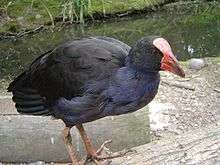Swamphen
Porphyrio is the swamphen or swamp hen bird genus in the rail family. It includes some smaller species which are usually called "purple gallinules", and which are sometimes separated as genus Porphyrula or united with the gallinules proper (or "moorhens") in Gallinula. The Porphyrio gallinules are distributed in the warmer regions of the world. The group probably originated in Africa in the Middle Miocene, before spreading across the world in waves from the Late Miocene to Pleistocene.[1]
| Porphyrio | |
|---|---|
 | |
| Australasian swamphen, Porphyrio melanotus in New Zealand | |
| Scientific classification | |
| Kingdom: | Animalia |
| Phylum: | Chordata |
| Class: | Aves |
| Order: | Gruiformes |
| Family: | Rallidae |
| Genus: | Porphyrio Brisson, 1760 |
| Type species | |
| Fulica porphyrio Linnaeus, 1758 | |
| Species | |
|
see text | |
| Synonyms | |
|
Notornis | |
The genus Porphyrio was introduced by the French zoologist Mathurin Jacques Brisson in 1760 with the western swamphen (Porphyrio porphyrio) as the type species.[2][3] The genus name Porphyrio is the Latin name for "swamphen",[4] meaning "purple".
Species
The genus contains ten extant species and two that have become extinct in historical times:[5]
Extant species
- Purple swamphen complex[6][1]
- Western swamphen, Porphyrio porphyrio
- African swamphen, Porphyrio madagascariensis
- Grey-headed swamphen, Porphyrio poliocephalus
- Black-backed swamphen, Porphyrio indicus
- Philippine swamphen, Porphyrio pulverulentus
- Australasian swamphen, Porphyrio melanotus
- South Island takahe, Porphyrio hochstetteri
- Allen's gallinule, also known as lesser gallinule, Porphyrio alleni (formerly Porphyrula alleni)
- American purple gallinule, Porphyrio martinicus (formerly Porphyrula martinica)
- Azure gallinule, Porphyrio flavirostris
Extinct species
- Lord Howe swamphen, Porphyrio albus (early 19th century)
- Réunion swamphen, or oiseau bleu, Porphyrio coerulescens (18th century, hypothetical species)
- Marquesas swamphen, Porphyrio paepae (prehistoric or c. 1900)
- North Island takahe, or mōho, Porphyrio mantelli (prehistoric or 1890s)
- New Caledonian swamphen, Porphyrio kukwiedei (prehistoric or more recent)
- Huahine swamphen, Porphyrio mcnabi (prehistoric)
- Buka swamphen, Porphyrio sp. (prehistoric)
- Giant swamphen, Porphyrio sp. (prehistoric)
- New Ireland swamphen, Porphyrio sp. (prehistoric)
- Norfolk Island swamphen, Porphyrio sp. (prehistoric)
- Rota swamphen, Porphyrio sp. (prehistoric)
- Mangaia swamphen/woodhen, ?Porphyrio sp. (prehistoric) - would belong into Porphyrula, Gallinula or Pareudiastes
References
- García-R, J.C.; Trewick, S.A. (2015). "Dispersal and speciation in purple swamphens (Rallidae: Porphyrio)". Auk. 122 (1): 140–155. doi:10.1642/AUK-14-114.1.
- Brisson, Mathurin Jacques (1760). Ornithologie, ou, Méthode Contenant la Division des Oiseaux en Ordres, Sections, Genres, Especes & leurs Variétés (in French and Latin). Paris: Jean-Baptiste Bauche. Vol. 1, p. 48, Vol. 5, p. 522.
- Peters, James Lee, ed. (1934). Check-list of Birds of the World. Volume 2. Cambridge, Massachusetts: Harvard University Press. p. 207.
- Jobling, James A (2010). The Helm Dictionary of Scientific Bird Names. London: Christopher Helm. p. 314. ISBN 978-1-4081-2501-4.
- Gill, Frank; Donsker, David, eds. (2019). "Chats, Old World flycatchers". World Bird List Version 9.1. International Ornithologists' Union. Retrieved 3 April 2019.
- Sangster, G. (1998). "Purple Swamp-hen is a complex of species" (PDF). Dutch Birding. 20 (1): 13–22.
- Taylor, P. Barry & van Perlo, Ber (1998): Rails: a guide to the rails, crakes, gallinules, and coots of the world. Yale University Press, New Haven. ISBN 0-300-07758-0
External links
| Wikimedia Commons has media related to |
- Swamphens fighting, Centennial Park, Sydney, YouTube
- Swamphens fighting, Centennial Park, Sydney, YouTube